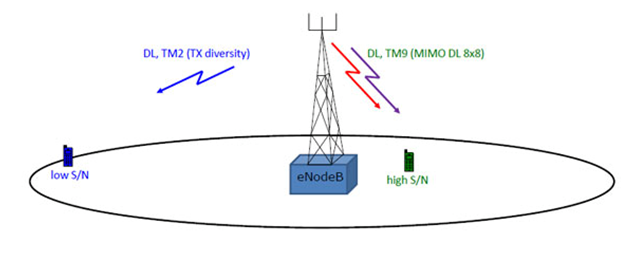Massive MIMO: A boost for Next Gen 5G wireless Communication
Cellular communication has been evolving a lot in the last decades through massive technological advancement. Experiencing a data speed of few kbps to accessing a bunch of data via video streaming, gaming or video call, totally different experience for a user. Development from the third generation to the fourth generation, the multi-input multi-output (MIMO) concept was introduced in cellular communication. MIMO implementation uses multiple antennas on both the source (base station-2/4) and destination (UE-2). MIMO enhanced the capacity and reliability of the network. Multiple streams help the user for accessing data with more speed. These advantages made MIMO a necessary element in standards i.e. 802.11n, HSPA+, WiMAX and LTE. 
Figure 1: MIMO is recommended for high S/N and Tx diversity [Source: 3GPP]
Bigger Scenario: Massive MIMO
For next Gen wireless communication MIMO gets “Massive”, in terms of the number of antennas at transmitter and receiver end both. While MIMO implementing 4×2, 4×4 antennas, Massive MIMO transforms the scenario up to the scale of 64 or 128 configurations.
Massive MIMO enhance MIMO concept up to hundreds or thousands of antennas and terminals. These massive number of antennas on a base station provides a focus of beam to the users instead of spreading energy in all direction.
 Figure 2: MIMO to Massive MIMO concept [Source: Mathworks]
Figure 2: MIMO to Massive MIMO concept [Source: Mathworks]
Beamforming:
Concept of beamforming or 3D beamforming may be possible only because of massive MIMO technology. Beamforming provides performance improvement of the overall network by enhancing user throughput and efficiency. User experience will be the same even on the edges of the network by providing a focused beam to that particular user. 3D Beamforming creates horizontal and vertical beams toward users, increasing data rates (and capacity) for all users — even those located in the top floors of high-rise buildings.
Figure 3: 3D Beamforming [Source: Qualcomm]
Advantages of Massive MIMO
- Increasing SNR: Massive number of antenna provides a better quality of signal in the cell region. Use of focused beam for users present in the cell region also increases the signal to noise ratio and provides quality of user experience.
- Increasing Capacity:Network capacity is the amount of traffic or data volume that a network can handle with a certain level of quality services. As number of antenna goes high, the number of streams may also get high for a user.
Multi-user MIMO (MU-MIMO) supports a scenario where multiple users are trying to access the network at the same time. MU-MIMO technology helps by allowing several users to access the network without congestion. Hence, Massive MIMO along with MU-MIMO enhances the capacity of the overall network.
- Increasing Coverage: Massive MIMO along with improvements in beamforming and beam management(beam switching, recovery and refinement) techniques increase coverage. User experiences a uniform quality of service through the cell region whether it is the center of the cell or on the edge.
Massive MIMO: Complexity and Challenges
- The major challenge with the massive MIMO system is the amount of baseband processing due to the huge amount of antenna usage.
- Massive MIMO system suffers from pilot contamination from nearby or other cells.
- Antennas demand phase synchronization among them.
- Power consumption per antenna needs to be reduced for achieving higher energy efficiency.
- Loop interference increases with an increase in spatial antennas.
- The complexity in channel estimation increases as the number of the antenna increases at both sides of the communication link.
Recent Testing and deployment
- For its network in Germany, Vodafone has deployed Ericsson’s Massive MIMO AIR 6488 commercial hardware and Baseband 6630 from the Ericsson Radio System portfolio.
- Samsung and Orange Romania have successfully deployed a 5G New Radio (NR) network to demonstrate a series of 5G use cases. The trial makes use of Samsung’s latest solutions, including 5G Massive MIMO Units (MMUs), which support the 3.4-3.8GHz frequency band. Samsung claims that the 5G MMUs have already been rolled out across Korea by all three Korean 5G operators for use with their 5G commercial service, which launched in April of 2019.
- Nokia and Sprint have jointly proven the benefits of massive MIMO in the TD-LTE 2.6 GHz band. Sprint becoming the first U.S. operator to demonstrate massive MIMO for TD-LTE spectrum using the Airscale massive MIMO Adaptive Antenna,64T64R, with 3D-Beamforming for both the downlink and uplink on an existing LTE frequency band.
MIMO has been deployed in last generation (4G) of wireless communication providing benefits in terms of enhanced capacity and better user experience. Now, Massive MIMO technology is one of the key concepts of 5G communication, going to play vital role in 5G deployment. Recent deployments proves its capability and essential presence in 5G scenario.


 English
English
